Disassembling and Taming Tube Guitar Sound
How it all began
About 5 years ago, I began my march through the world of lamp technology. During this time, dozens of different circuits were assembled and about five dozen “original” tube amplifiers were listened. As a result, a clear understanding was formed of “how it should sound” and what “flexibility” the device should have.
In the process of getting to know different guitar amps, for a long time, the sound of the “head” from Krank firm did not leave me alone. But at that moment, unfortunately, it was impossible to evaluate and try it. Sales began just in the United States, and there were no live specimens in St. Petersburg. It was decided at all costs to get such a “tidbit”. Fortunately, there were suitable people who could buy and bring it to St. Petersburg. The long 14 days of waiting and my charm stood on the threshold of the apartment. Fortunately there was no limit. The more I played it, the more I got the idea: "How is this thing."
At one fine moment, having gathered my courage, I firmly decided: “I must find out the“ secret ”of this miracle.”
Days passed, weeks flew. Piece by piece, a pattern loomed.
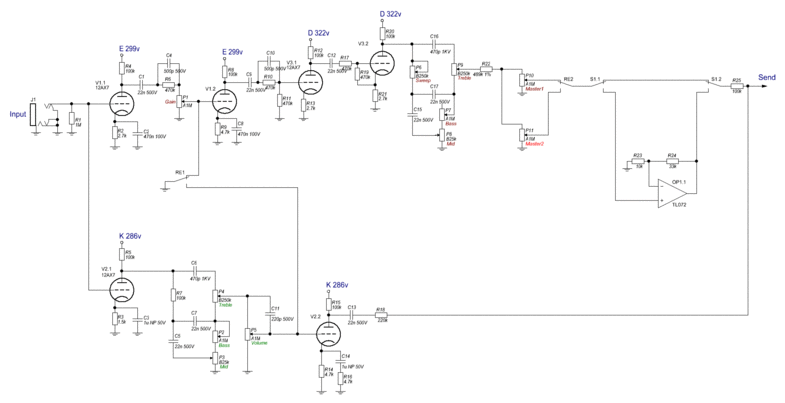
This, it would seem, was worth stopping, but the soul required continuation. And so the idea was born to make a portable, lightweight "krank" for playing outside the rap. points.
And then it started ...
Housing
The case was decided to take in the rackmount format (for ease of storage and transportation). Solution advantages:
Convenience of installation in a river / studio rack, durability, good cooling, convenience of location and wiring of the “vnutryanka”.
Hammond 2U 19 "Rack mount Case was used.
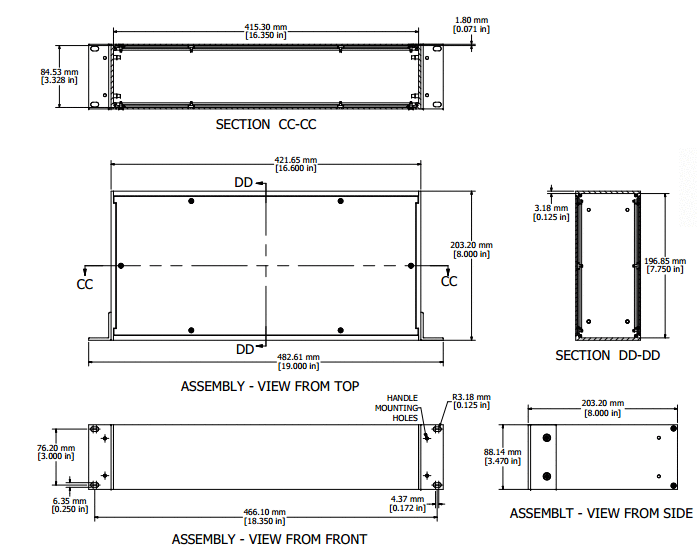
Transformer
I will make a reservation right away that many transformers have been tried, but Transled turned out to be the most adequate in price and dimensions (do not count it for advertising).

I chose a power transformer according to the following parameters:
3 lamps - 12ax7, switching and indication.
Total we have:
1. A winding of 6-15 volts for power supply of incandescent lamps and switching.
2. High-voltage winding to power the anodes of the lamps.
Open the 12ax7 EH lamp datasheet and see:
Filament (heater) - 150ma (12.6v) or 300ma (6.3v)
Anode (Anode) - 10ma.
Indication and switching - 200ma.
Total minimum:
6.3v winding - at least 1.2A; 260-300v
winding - 30ma
With a margin:
6.3v winding - at least 1.8A; 260-300v
winding - 50ma
Tip:
In no case do not use transformers "changeling" for power. Extremely negatively affects the sound and background.
Take the transformer with a margin, because the work on the range turns around - overheating. Isolation shrinks faster, which leads to trouble and time spent. Desired nutritional reserve ~ 20-25%. There were cases when, due to power, a very strong background appeared in the sound.
Power Supply
In the course of long research, I came to the conclusion that the power supply of the filament (for hi-gain) of the amplifiers must be stabilized, rectified. For my preamplifier, I used a power supply based on an adjustable voltage regulator Lm317T.
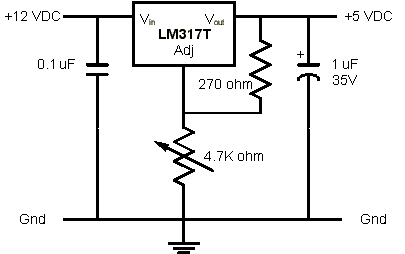
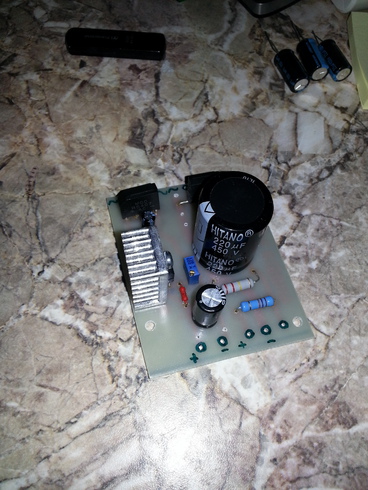
Components
I bought all components in an online store (in Canada). Although by and large, it doesn’t matter where they were bought and from whom, the main thing is to follow simple rules:
1. Do not take noname electrolytic capacitors and “completely china”.
(I advise companies like Nichicon, Jamicon, Hitano, Vishay, Silver mica, Sprague.)
2. Do not save money on wires. For switching and timbre. unit I recommend our MGTF, for power units (power), you can use MGShV.
3. Do not install ceramic capacitors in hi-gain preamps or amplifiers. More often than not, they make a ringing sound. I advise you to use Silver mica or ours, Soviet mica capacitors (Very good SGM, KSO).
4. Feed-through (capacitors on the anode circuit) and in the cathode circuit is best used with a film or polystyrene dielectric. (Wima, Rifa, Epcos are very good).
5. Well, of course, take everything with a voltage margin of 20-25%.
Lamps
Absolutely any 12ax7. Personally, I prefer 12ax7 EH for a tight, medium read overload. 12ax7 Tung Sol for a clean channel or in a mix with EH for more detail in the high mid range and high frequencies at overload.
Printed circuit boards and technology for their manufacture
To be honest? It is desirable to make all the lamp technology on a turret board, but due to the fact that we do not manufacture hi-end, the good old printed circuit boards based on foil-coated textolite will also come off. For tube circuits, I use a one-sided, one and a half millimeter textolite, with the thickest layer of copper foil.
As a rule, I print a blank (stencil) of a printed circuit board on a transparent film.
I clean the textolite plate with foil with fine sandpaper, wash it with soap under running water, degrease it, wipe it dry.
Spray on the surface with a uniform layer of POSITIVE 20 and lay in a dark place to dry.
After 5-7 hours, I put the stencil and illuminate through Plexiglass glass with a 150-watt halogen spotlight for 1.2-1.5 hours.
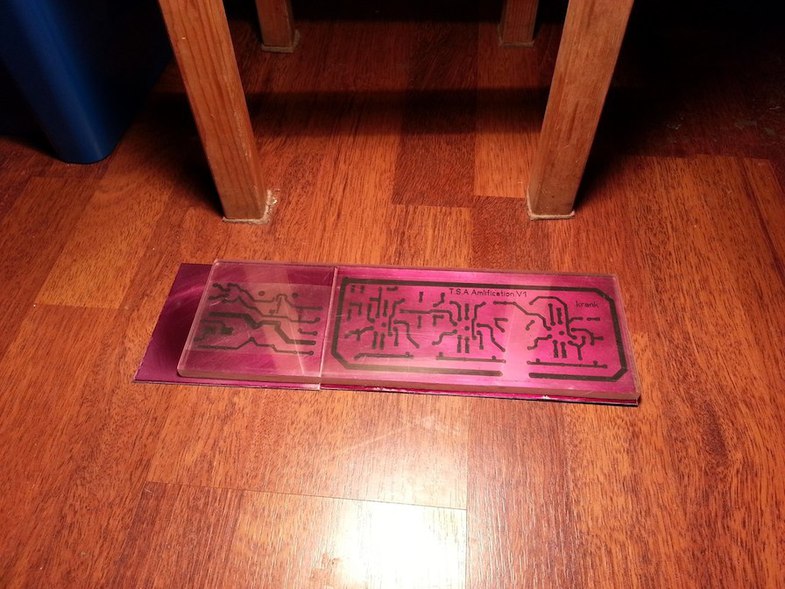
Then I dilute 7 g of sodium hydroxide per liter of warm water, mix. I throw our illuminated board there and interfere with the water so that the exposed photoresist dissolves more actively. In common people, I show a fee.
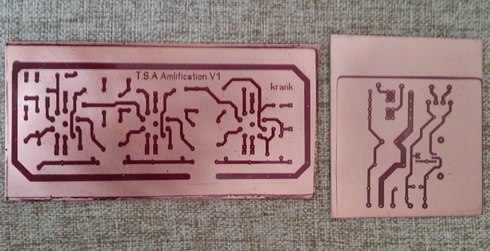
Next, take the tray, pour boiling water, throw ferric chloride and etch the board.
At the end of the procedure, we drill holes and conduct a session of sealing elements.
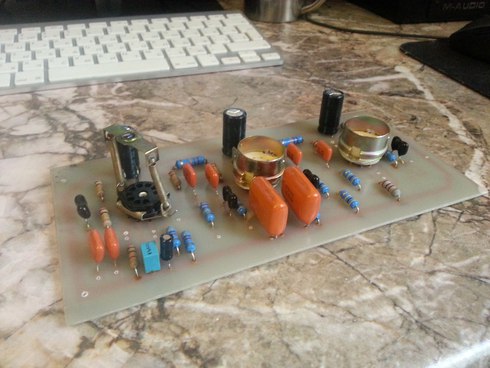
Housing assembly and tuning tips
We mark the places for the installation of "racks" for mounting the board. We drill holes and fix the racks.
We begin the assembly. As a rule, I start the assembly with the timbre of the block, since I prefer to solder it partially with a canopy.
Wires, as a rule, try to fasten with ties.

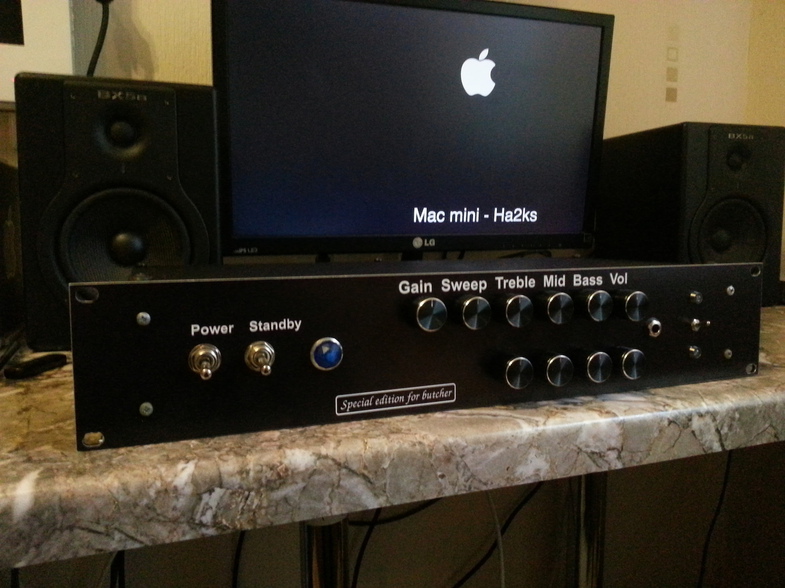
Simple assembly rules:
Do not fasten signal and power wires in one bundle, otherwise problems with the background cannot be avoided.
Try to hold the filament chains of the lamps with a “pigtail”.
Lamp nets, always lead in shielded wires.
Input and output wires require shielding.
The input connector (signal contact) with a non-stuck guitar, it is advisable to ground.
Bring the earth in one place on the body. Make sure that no earth loops form.
Solder the glow plugs through 100 ohm resistors (0.5w) to ground.
All the above “recipes”, with the correct board and assembly without errors, give a quiet amplifier and sound pleasing to your ears.
Thanks to all.
Ps
I hope I didn’t starve you a long article. If you have any questions - write.
I almost forgot ... The secret was that the new - the well-forgotten old. Krankenstein turned out to be a 90% copy of the marshal, with almost imperceptible changes in the preamplifier and tip on the 6L6 WGC.
References
Archive with diagrams and signet made in sprint layout 5
Video (Distortion chanel) Played and recorded - friend.
Video (Clean chanel)
Audio Wrote in a line. Focusrite saffire map.
